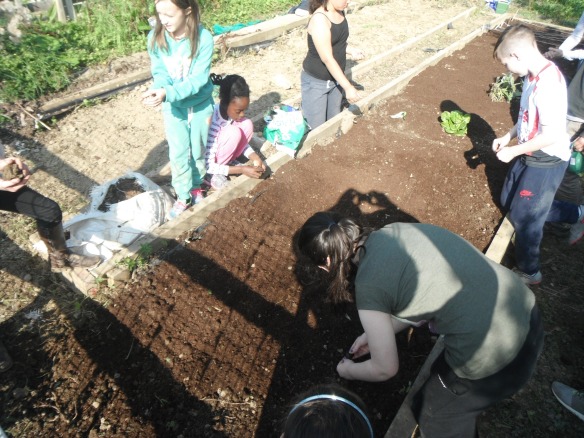In recent months I been having a great time visiting primary schools and running workshops in all things nature. I think it’s nice to know a little bit about the “real world” we live in and some of it’s magic. Below we explored a hedge row on a bit of waste ground near some allotments. We talked about the importance of hedges and at how untended plants grow without any help. What tips and tricks could observing a hedge offer us in our allotment garden? What effect does a hedge have on the wind, the sun, the creatures we might likely find? If we don’t have a “garden” at home could this hedge be our garden as we pass by on the way to school, a place where we come to observe , nibble and relax in this busy world of ours. Just because you don’t have a garden does’nt mean you cannot garden. What exactly is gardening anyway?

The approach I’m trying to take is what could be called Keeping it real, sometimes a challenge for a teacher but a natural state of happiness to most children. Basically this means getting your clothes dirty, getting wet and doing something real, we are living in Ireland lets not forget.

Each visit is completely different and very much influenced by those one or two key teachers a school might be luck enough to have who see the importance in the natural world, food, health and the development of a love of nature. Again and again teachers from different schools have told me about how they grew up in a rural setting and spent their days out playing. This contrasts to how many children now grow up in urban environments in a very different culture.
I was surprised to find that in most classes there are a usually a few children who have never handled compost or soil. Thats dirty they might say , yes ” Good Dirt” . By far the best and most interesting discoveries are made poking about in the soil with a trowel. A simple worm is so exciting that it’s important to do a worm count before any activities where they might be uncovered.
Simple stringlines using bamboo and twine are an excellent way to practice measurements in cm and Inches. A hand trowel is all that is required for most jobs with so much energy.


In go the broadbeans, garlic onions and green manures. In this pic the 4 foot wide beds make it difficult to reach the middle and the narrow paths make it a challenge for access with a group. This style of bed would be better with 4 foot paths for access and 3 foot beds for reaching into. Designing a garden for a class of 24 to 34 children to have space to work in at a number of stations is important to carefully consider from the start.

I was very luck to spend a week working with the Ballyroan boys gardening club. Over the week we mulched the paths with cardboard and woodchips kindly droped by Setanta tree care, built a composting system from free pallets and filled the raised beds with soil for planting.


The boys from the gardening club are great workers often giving up their lunch break in yard to do gardening. Here they are clearing an area to make a pallet composter.



The boys in the gardening club get out regularly into the garden to do work. Here we are fixing some mesh to steps to improve the grip in the winter.


Its amazing once everyone gets stuck into the jobs how quiet everyone gets, working away on their project.


Lining out the braodbeans

The project is ongoing and we look forward to catching up again in the spring. That was a great week despite the rain.
